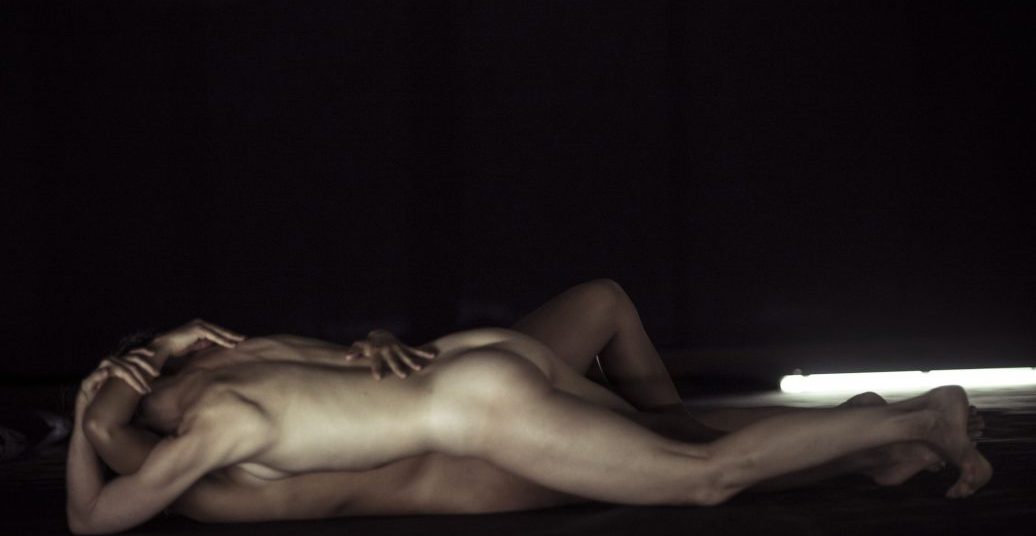On 19 October 2021, Eszter Salamon’s new work “MONUMENT 0.9: Replay” premiered in HAU1. The nearly two-hour evening built on the 2004 group performance “Reproduction” and, under the gaze of the viewers, lays out a straightforward treatise on pleasure.
The audience is guided backstage at the start of the piece. The five performers (Ghyslaine Gau, Arantxa Martinez, Pol Pi, Lola Rubio, and Eszter Salamon) are already lying in the center of the space on the rectangular cork floorboard as we find seats on all four sides. There are two large, flat bean bag chairs at the edge of the stage, which will later serve as islands or havens. There are also four mirrors distributed along the sides that hover above the stage at an angle so that the exposed bodies can also be partially observed from different perspectives. It is quickly obvious that the piece is about physicality and intimacy. The performers are unclothed for the duration of the piece, and this nudity is pivotal since the work is dedicated to the skin as the largest organ and “the locus of sensing, vibrating, and relating”, according to the program text. The fact that the audience is spread all around and extremely close to the action is also conceptually relevant. This is meant to be a mutual space for spectators and performers, which the program text also explains. As clothed and masked spectators, we witness the events on seat cushions from a flat platform. As such, it is naturally and primarily a theatrical observation point that allows us to participate. From this perspective, we are primarily called upon to come to terms with our voyeuristic situation. That listening can also be a form of touching is later on announced over the loudspeakers.
The entire piece consists of very slow movements that, especially in the beginning, mainly take place on all fours, crawling or lying down, always close to the ground. Oriented towards an ever-changing counterpart, the five bodies purposefully move towards each other in order to slide over or among one another and once again disengage. Every physical point of contact in this process appears to be intentional and deliberate. I never see a hand simply pulled away. It is always a long graze and a slide along limbs and skin surfaces until, due to the opposing direction of movements, they simply separate. This passing over and temporary immersion into warmth and skin contact, which is evidently enjoyed, shapes the intensity of the piece at a sensual level.
At first, the auditory level is marked by restrained, breezy whispers. Later the performers’ voices and audio recordings are incorporated into the sensory performance of the piece. Initially noises reminiscent of wolves or dogs howling in pain can be heard. At first I can not determine with certainty whether these sounds are from the performers themselves or a recording. This is also because they keep their faces averted for a long time and the creation of the sometimes powerful sounds is not necessarily physically discernible. However, in one of the scenes, a sort of calling song clearly unfolds between two of the performers. And in the course of this interaction, both of them rise from the floor for the first time into an upright position. They lean against one another or hold each other with outstretched arms. It seems like a joint attempt to test out this vertical level. Later on, audio track narratives support this interpretation of evolution and incarnation. Specifically: “In the beginning there was touch. Then you touched”. And the associative treatises on bacteria, moss, and underwater creatures also paint this picture of becoming. By its very nature, the topic of becoming dwells within intense physicality. On the one hand, it is vital touches that help shape our physical places of longing and emotional landscapes. On the other hand, every so often the fruit of these intense bodily encounters is of course new life itself.
The fact that intimacy and physical closeness did not have to be understood as explicitly sexual for a long time is a special quality of the work. While the contact between the naked bodies was intimate and sensually exploratory at the outset, this level of touch only develops into a tangibly sexual one in the last third of the two hours. The various sexual positions, which the bodies pass through in alternating combinations, soon seem exaggerated and at times ironic. Gestures, like the lustful pulling of hair, deliberately draw on stereotypical images of desire, but also power. Some viewers might have wondered whether this was still art or already sex when confronted with the aforementioned voyeuristic situation. My own answer was that this is an unnecessary distinction. Attempting to come to terms with physicality and touch in such an open, vulnerable, and shameless way, even in a sexual dimension, is an art.
English translation by Melissa Maldonado
„MONUMENT 0.9: Replay“ with and by Eszter Salamon is still running until 22 October 2021 at HAU1. Further information about the artist and her work can be found under esztersalamon.net.




